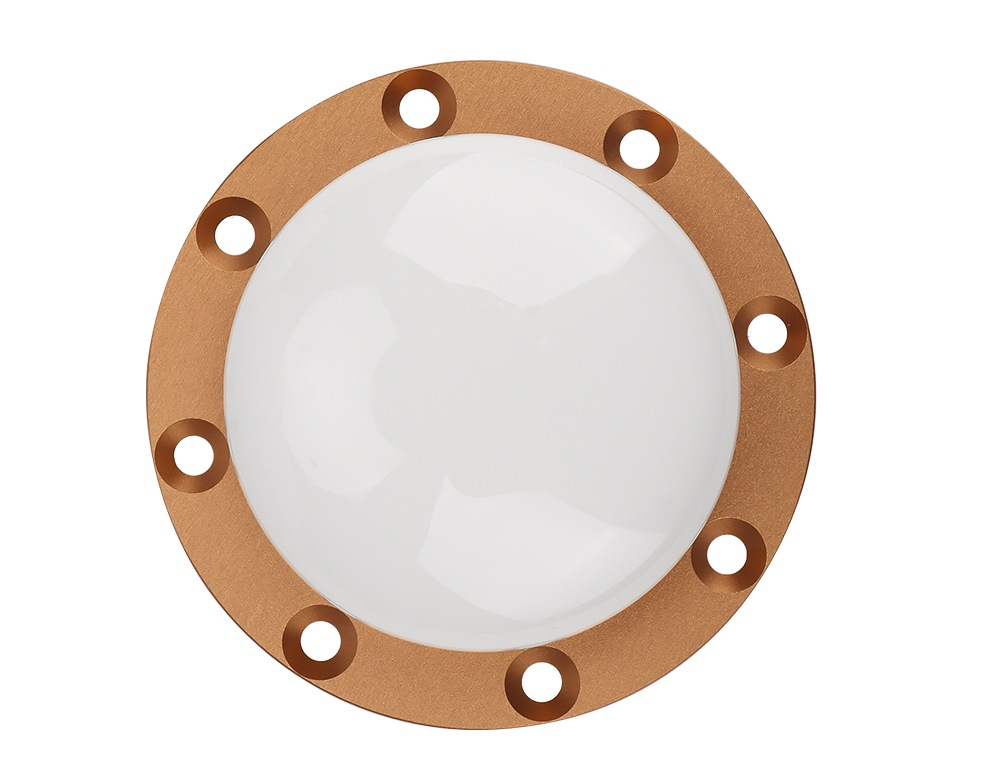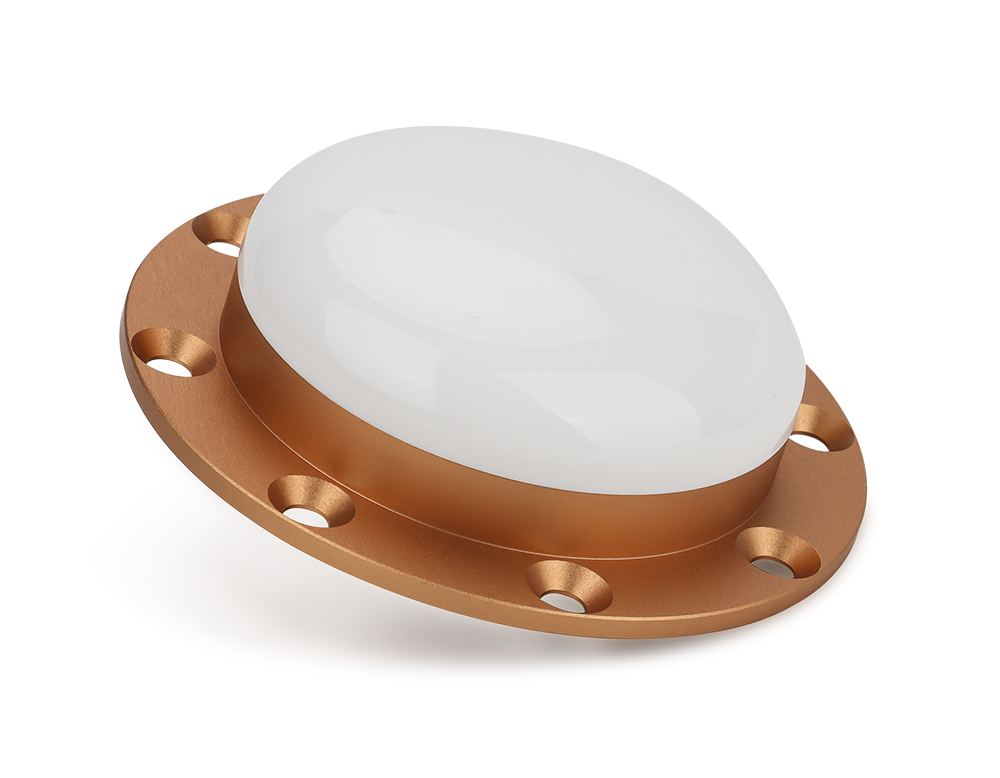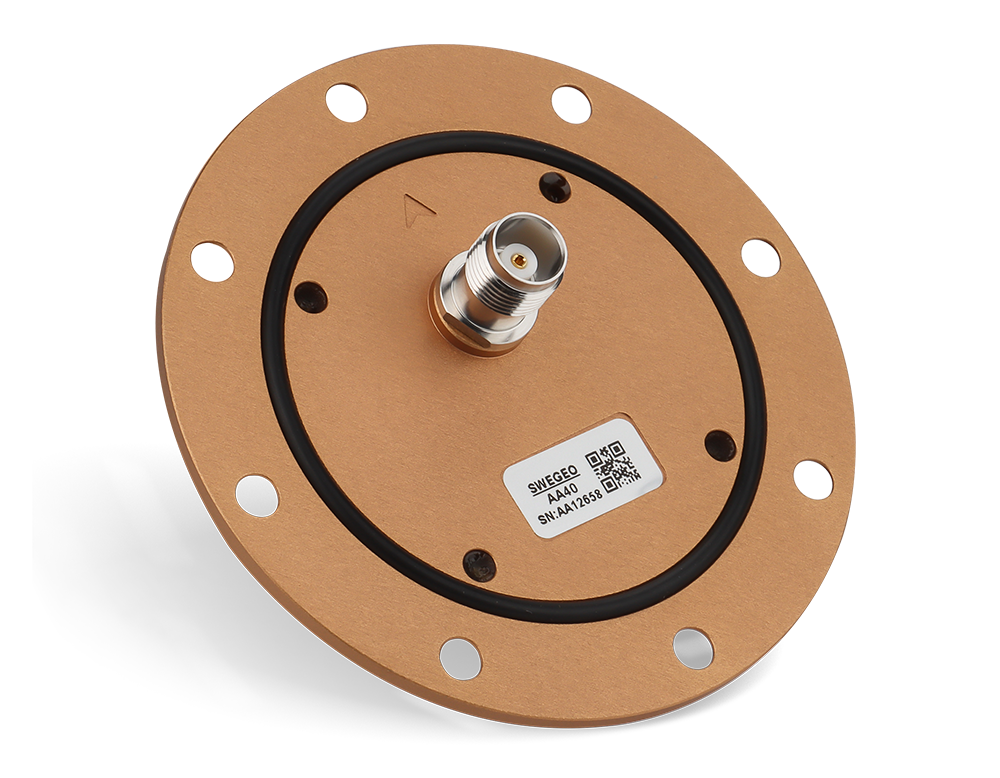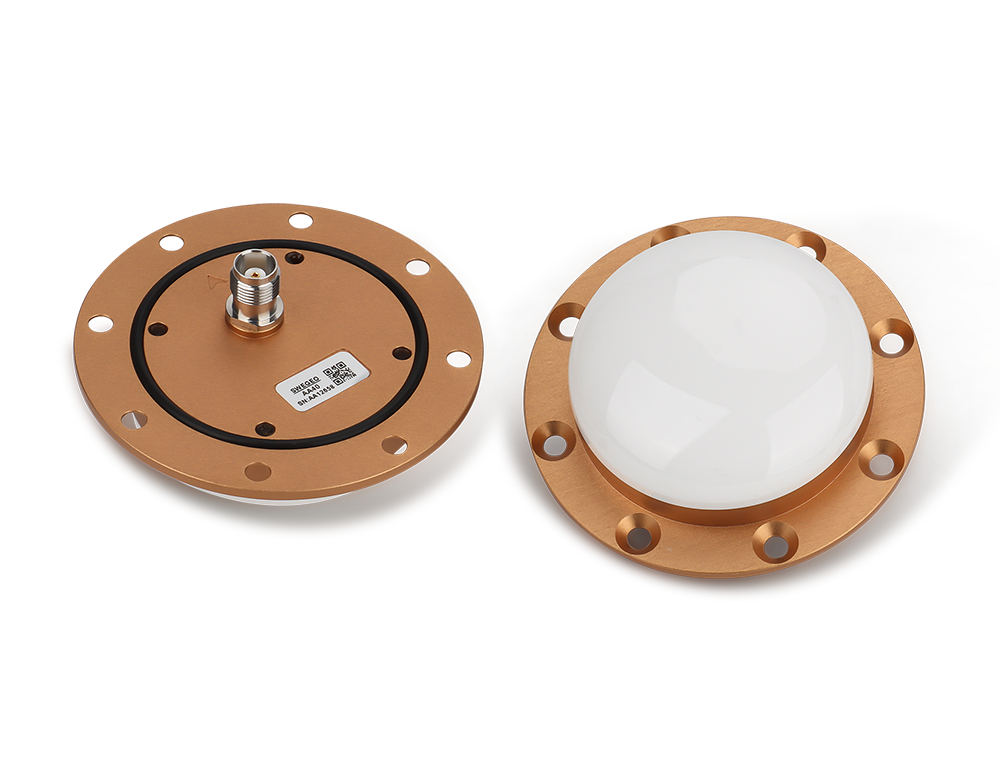


Swegeo AA40
Airborne GNSS Antenna
Key Feature
- Swegeo AA40 is a multi-constellation and multi-frequency Survey-Grade GNSS antenna that supports GPS, GLONASS, GALILEO, BEIDOU, QZSS, IRNSS, SBAS and L-Band.
High Gain Reception & Reliable Low-Noise Amplifier for Optimal Satellite Tracking
It is widely used in high-precision navigation and positioning applications in high dynamic environments such as aerospace, UAV, precision agriculture, ADAS, Autonomous Driving where aerodynamics play an crucial role while accuracy and reliability are not sacrificed.
Enhanced Performance and Precision
Double layer multi-feed point technology ensures high performance on right-hand circular polarization and phase center stability. It further lowers the measurement errors.
Optimized Reception
The overall design provides a high gain on low-elevation satellite signal reception so that a higher number of satellites are available for position calculation.
Improved Signal Quality
Pre-filtering on the low noise amplifier effectively suppresses out-of-band interference signals and improves the reliability of the system.
Versatile and Durable
The enclosure is rated IP67 which ensures a reliable performance in any harsh environmental conditions.
Land Surveying Base Stations:
The AA40 is a survey-grade antenna ideal for use on tripods or fixed mounts as an RTK base. Surveyors setting up temporary base stations at a job site rely on the AA40’s full GNSS spectrum support and stable phase center to provide consistent correction data. When placed on a known point, an AA40 can gather signals from all visible satellites (GPS, GLONASS, Galileo, BeiDou, etc.) with high gain, even those at low elevation angles. This results in a robust data stream to send to rovers, improving the reliability and accuracy of the entire RTK network. Its durable, waterproof design stands up to extreme heat, cold, or rain, which is essential when a base might be left running for days or weeks at remote sites.
Deformation Monitoring & Reference Stations:
Geodetic monitoring installations, such as those tracking earth crust movements or infrastructure stability, use AA40 antennas for their reference receivers. The antenna’s survey-grade build (including a very stable phase center and low multipath characteristics) ensures that any slight movement observed is due to actual ground or structure motion, not antenna inconsistency. For instance, on a dam or bridge, AA40 antennas can be mounted at strategic points and connected to continuously operating receivers. Over months and years, they deliver the kind of repeatable measurements needed to detect millimeter-scale shifts. The ability to cover multiple frequencies also means these reference stations can take advantage of modern correction services or advanced processing (like double-differencing on various frequencies) to improve long-term accuracy.
High-Precision Vehicle Navigation:
The AA40 can be installed on the roofs of vehicles that require survey-grade navigation, such as mapping vans, agricultural combines, or prototype autonomous cars. Its slightly larger size (around 90 mm diameter) compared to smaller antennas gives it a higher gain and phase center stability on a ground plane (like a vehicle roof). When a mapping van drives through a city, the AA40 helps its receiver maintain lock on more satellites at low elevations (between buildings) than a smaller antenna might, thereby extending the uptime of RTK or PPP fixes. The ruggedness and magnetic or screw mounting options allow these antennas to be securely attached to vehicles that drive over rough terrain, ensuring continuous operation without recalibration.
| Feature | Specification | Feature | Specification |
|---|---|---|---|
| Signal Supported |
GPS: L1/L2/L5 BDS: B1/B2/B3 GLONASS: G1/G2/G3 Galileo: E1/E5a/E5b L-Band |
Architecture | Dual Four-point-feed, Dual Stacked Patch |
| Nominal Impedance | 50 Ω | Polarization | RHCP |
| Axial Ratio @ zenith | ≤1.5 dB | Gain @ zenith | ≥4.0 dBi @ Fc (with 100 mm ground plane) |
| Phase-center accuracy | ≤2.0 mm | Phase-center repeatability | ≤1.0 mm |
| Dimensions | Φ90 mm × 27 mm | Connector | TNC (Female) |
| Weight | 150 gram | Radome | ABS+P |
| Attachment | Four screw holes | Vibration / Shock |
Vibration: 3 axis, sweep=15 min, 10–200 Hz sweep: 3G Shock: Vertical axis 50G, other axes 30G |
| Frequency Range | 1164 MHz ~ 1286 MHz, 1525 MHz ~ 1615 MHz | LNA Gain* | 38 ±3.0 dB (Typ. @25°C) |
| Noise Figure* | ≤2.0 dB @25°C Typ. (Pre-filtered) | Output VSWR | ≤1.5:1 typ., 1.8:1 max |
| Operation Voltage | 3.0 – 16 VDC | Operation Current | ≤50 mA |
| Output of Band Rejection |
L5/E5/L2/G2/B2: <1050 MHz: >55 dB <1125 MHz: >30 dB >1350 MHz: >45 dB L1/E1/B1/G1: <1450 MHz: >40 dB >1690 MHz: >40 dB >1730 MHz: >45 dB |
Ingress Rating | IP67 |
| Operating Temperature | -40°C to +85°C | Storage Temperature | -45°C to +85°C |
| Humidity | 95% Non-condensing |



Swegeo AA40
Helical GNSS Antenna
Key Feature
- Swegeo AA40 is a multi-constellation and multi-frequency Survey-Grade GNSS antenna that supports GPS, GLONASS, GALILEO, BEIDOU, QZSS, IRNSS, SBAS and L-Band.
OVERVIEW
High Gain Reception & Reliable Low-Noise Amplifier for Optimal Satellite Tracking
It is widely used in high-precision navigation and positioning applications in high dynamic environments such as aerospace, UAV, precision agriculture, ADAS, Autonomous Driving where aerodynamics play an crucial role while accuracy and reliability are not sacrificed.
Enhanced Performance and Precision
Double layer multi-feed point technology ensures high performance on right-hand circular polarization and phase center stability. It further lowers the measurement errors.
Optimized Reception
The overall design provides a high gain on low-elevation satellite signal reception so that a higher number of satellites are available for position calculation.
Improved Signal Quality
Pre-filtering on the low noise amplifier effectively suppresses out-of-band interference signals and improves the reliability of the system.
Versatile and Durable
The enclosure is rated IP67 which ensures a reliable performance in any harsh environmental conditions.
USE CASES
Land Surveying Base Stations:
The AA40 is a survey-grade antenna ideal for use on tripods or fixed mounts as an RTK base. Surveyors setting up temporary base stations at a job site rely on the AA40’s full GNSS spectrum support and stable phase center to provide consistent correction data. When placed on a known point, an AA40 can gather signals from all visible satellites (GPS, GLONASS, Galileo, BeiDou, etc.) with high gain, even those at low elevation angles. This results in a robust data stream to send to rovers, improving the reliability and accuracy of the entire RTK network. Its durable, waterproof design stands up to extreme heat, cold, or rain, which is essential when a base might be left running for days or weeks at remote sites.
Deformation Monitoring & Reference Stations:
Geodetic monitoring installations, such as those tracking earth crust movements or infrastructure stability, use AA40 antennas for their reference receivers. The antenna’s survey-grade build (including a very stable phase center and low multipath characteristics) ensures that any slight movement observed is due to actual ground or structure motion, not antenna inconsistency. For instance, on a dam or bridge, AA40 antennas can be mounted at strategic points and connected to continuously operating receivers. Over months and years, they deliver the kind of repeatable measurements needed to detect millimeter-scale shifts. The ability to cover multiple frequencies also means these reference stations can take advantage of modern correction services or advanced processing (like double-differencing on various frequencies) to improve long-term accuracy.
High-Precision Vehicle Navigation:
The AA40 can be installed on the roofs of vehicles that require survey-grade navigation, such as mapping vans, agricultural combines, or prototype autonomous cars. Its slightly larger size (around 90 mm diameter) compared to smaller antennas gives it a higher gain and phase center stability on a ground plane (like a vehicle roof). When a mapping van drives through a city, the AA40 helps its receiver maintain lock on more satellites at low elevations (between buildings) than a smaller antenna might, thereby extending the uptime of RTK or PPP fixes. The ruggedness and magnetic or screw mounting options allow these antennas to be securely attached to vehicles that drive over rough terrain, ensuring continuous operation without recalibration.
TECHNICAL SPECIFICATIONS
| Feature | Specification | Feature | Specification |
|---|---|---|---|
| Signal Supported |
GPS: L1/L2/L5 BDS: B1/B2/B3 GLONASS: G1/G2/G3 Galileo: E1/E5a/E5b L-Band |
Architecture | Dual Four-point-feed, Dual Stacked Patch |
| Nominal Impedance | 50 Ω | Polarization | RHCP |
| Axial Ratio @ zenith | ≤1.5 dB | Gain @ zenith | ≥4.0 dBi @ Fc (with 100 mm ground plane) |
| Phase-center accuracy | ≤2.0 mm | Phase-center repeatability | ≤1.0 mm |
| Dimensions | Φ90 mm × 27 mm | Connector | TNC (Female) |
| Weight | 150 gram | Radome | ABS+P |
| Attachment | Four screw holes | Vibration / Shock |
Vibration: 3 axis, sweep=15 min, 10–200 Hz sweep: 3G Shock: Vertical axis 50G, other axes 30G |
| Frequency Range | 1164 MHz ~ 1286 MHz, 1525 MHz ~ 1615 MHz | LNA Gain* | 38 ±3.0 dB (Typ. @25°C) |
| Noise Figure* | ≤2.0 dB @25°C Typ. (Pre-filtered) | Output VSWR | ≤1.5:1 typ., 1.8:1 max |
| Operation Voltage | 3.0 – 16 VDC | Operation Current | ≤50 mA |
| Output of Band Rejection |
L5/E5/L2/G2/B2: <1050 MHz: >55 dB <1125 MHz: >30 dB >1350 MHz: >45 dB L1/E1/B1/G1: <1450 MHz: >40 dB >1690 MHz: >40 dB >1730 MHz: >45 dB |
Ingress Rating | IP67 |
| Operating Temperature | -40°C to +85°C | Storage Temperature | -45°C to +85°C |
| Humidity | 95% Non-condensing |




